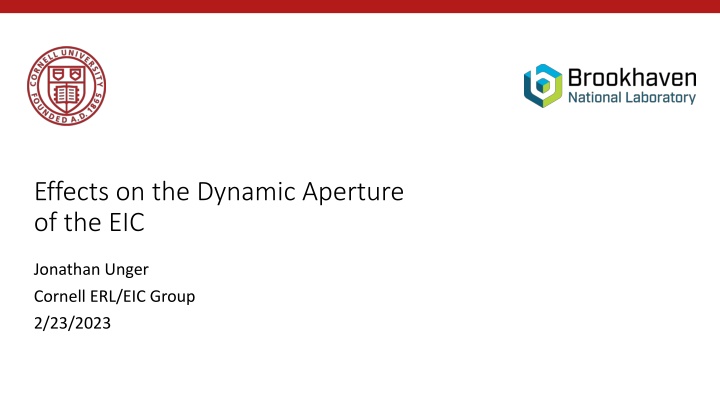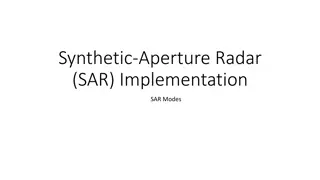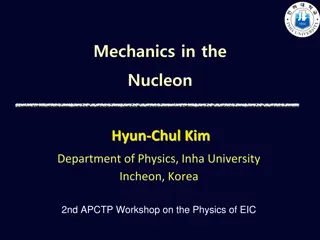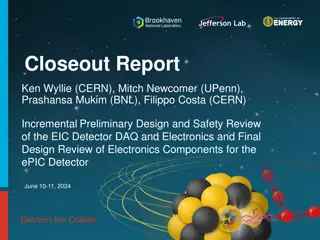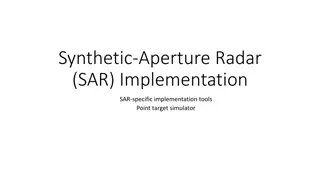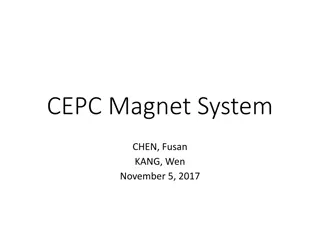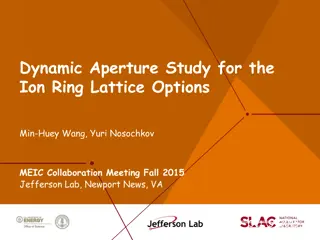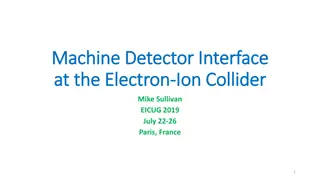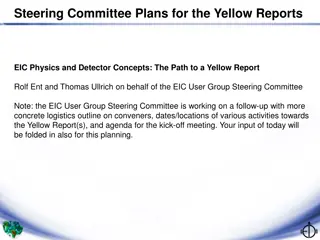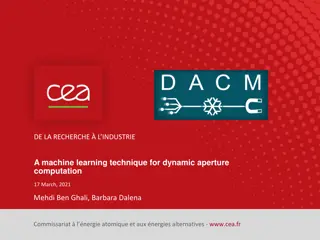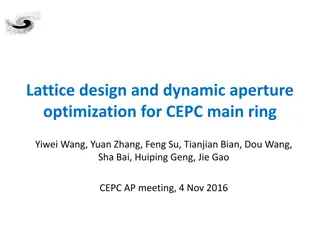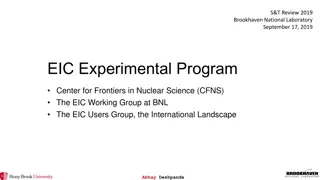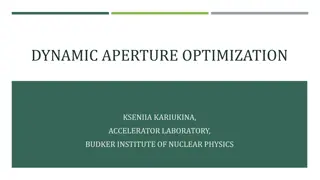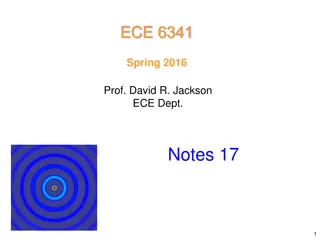Effects on Dynamic Aperture of EIC: Understanding Non-Linearities and Optimization
The Electron-Ion Collider at Brookhaven National Laboratory features two rings - Hadron Storage Ring and Electron Storage Ring - with a large energy range of 30GeV to 140GeV. This article delves into the concept of Dynamic Aperture, exploring how non-linearities impact particle stability and ways to optimize dynamic aperture through energy-dependent tune and second-order dispersion. With detailed examples and insights on second-order dispersion and W-function, learn how to enhance collider performance.
Download Presentation

Please find below an Image/Link to download the presentation.
The content on the website is provided AS IS for your information and personal use only. It may not be sold, licensed, or shared on other websites without obtaining consent from the author.If you encounter any issues during the download, it is possible that the publisher has removed the file from their server.
You are allowed to download the files provided on this website for personal or commercial use, subject to the condition that they are used lawfully. All files are the property of their respective owners.
The content on the website is provided AS IS for your information and personal use only. It may not be sold, licensed, or shared on other websites without obtaining consent from the author.
E N D
Presentation Transcript
Effects on the Dynamic Aperture of the EIC Jonathan Unger Cornell ERL/EIC Group 2/23/2023
Electron-Ion Collider To be constructed at Brookhaven National Laboratory Collides electrons and hadrons 2 rings: Hadron Storage Ring (HSR) Electron Storage Ring (ESR) Large energy range: (30GeV-140GeV) Polarized beams
Electron Storage Ring Focus on 18 GeV 2 Possible interaction points (IP) Beam size at IP h/v [ m]: 119/11 Electrons only Collide at one IP
What is Dynamic Aperture? Physical Aperture Like physical aperture, a particle is lost if it does not stay inside (stable phase space) Dynamic Aperture Non-linearities reduce dynamic aperture
Example Non-Linearities Sextupole gives a non-linear kick: ? = 1 2?2?(?2 ?2) Quadrupoles have a non- linear energy dependence ? < 0 ? > 0 ? = 0 ?1? =?10 1 + ?
Optimizing Dynamic Aperture Energy Dependent Tune W-Function Second Order Dispersion
Energy Dependent Tune Second order chromaticity Design tune ? ? = ?0+ ?1? + ?2?2+ Higher order chromaticity Chromaticity Flatter tune gives more stability
W-function ?2+ ?2 ?? ??, W = ? =?? ?? ? ? =1 ?? ?? ? ? ?0+? ?? ?1? ?2? ??? ??,?(?)?2? ??,?? ??,?(?0) ?0 Modulus is W-function
Second order dispersion Second Order Dispersion x ? = ?0+ ?0? + ?1?2+ ?2?3+ Also: x ? = ?0+ ?1? + ?2?2+ ?3?3+ Second order dispersion + 2 ?1?2= + 2 2 ?1+ ?1 ?1+ 2 ?1 3+1 2+1 2 ?2 2?2 ?1 2 ? 1 Caused by bending Where = 1/? Corrected with sextupoles
DA Goals for ESR Transverse: 10 Longitudinal: ? = 1%
Single sextupoles for second order dispersion Baseline Lattice Correction Sextupoles in each arc are grouped into families to control W-function and chromaticity Optimization by Yunhai Cai (SLAC) Sextupoles off Sextupoles on
Baseline Lattice Results Optimization is just shy on momentum aperture Transverse aperture is large with room for errors Optimized without all features
Need to Include Crab Cavities Beam-Beam Detector Solenoid and Correction
Crab Cavities EIC will collide with a 25mrad crossing angle due to many bunches The crossing angle reduces collisions per bunch Crab cavities are used to keep head on collisions Luckily, no noticeable impact to DA
Beam-Beam Modelling Beam-Beam represented as a thin lens Weak-Strong model Beam-Beam parameter h/v: 0.093/0.10
Crab Cavities with beam-beam Particles in the beam tails will be kicked slightly off Crab cavity kick: ? (?) sin(??) Thin lens beam-beam does not pick this up Zero from sine kick Assemble many thin lens beam-beam interactions along centroid Left over term Main crabbing ??? = crab?1? + crab?2?2+ crab?3?3+ crab?4?4+ crab?5?5 Corrected by second crab cavity
Results with Beam-Beam and Crabbing Transverse aperture remains acceptable Momentum aperture drops to 0.6%
Detector Solenoid Detector solenoid introduces coupling in the IR ?11 ?21 0 0 ?12 ?22 0 0 0 0 0 0 In IR without solenoid: ?33 ?43 ?34 ?44 ?11 ?21 ?31 ?41 ?12 ?22 ?32 ?42 ?13 ?23 ?33 ?43 ?14 ?24 ?34 ?44 Coupling messes with crabbing In IR with solenoid: ?11 ?21 0 0 ?12 0 0 0 0 0 0 0 ????? 0 0 0 0 ?11 ?21 ?31 ?41 ?12 0 ?32 ?42 ?13 ?23 ?33 ?43 ?14 ?24 ?34 ?44 0 ? 0 ? ? ? 0 0 ? 0 0 = = ?33 ?43 ?34 ?44
Vasiliy Morozov (Oak Ridge National Laboratory) Derong Xu (Brookhaven National Laboratory) Detector Solenoid correction ?11 ?21 ?31 ?41 ?12 0 0 0 ?13 ?23 ?33 ?43 ?14 ?24 ?34 ?44 Need to correct the crabbing plane Crab1 IP: ?11 ?21 ?31 ?41 0 ?13 ?23 ?33 ?43 ?14 ?24 ?34 ?44 Need to correct coupling in the region ?22 0 0 Crab1 Crab2: ?11 ?21 0 0 ?11 ?21 ?12 ?22 0 0 ?12 ?22 0 0 0 0 Skew quadrupoles added for correction In IP: ?33 ?43 ?34 ?44 0 0 0 0 No room between the crab cavities and IP to fully correct coupling In out: 0 0 0 0 ?33 ?43 ?34 ?44
Results with Detector Solenoid (1-IP) Great Results. Including crabbing and beam-beam
Results with Detector Solenoid (2-IP) Large W-function and second order dispersion Dynamic aperture is quite poor
Reoptimizing the 2-IP case Needs to go, Still under optimization Still falls short, needs more optimization
Conclusion Dynamic aperture is the phase space with stable particle motion Baseline ESR lattice has good DA Crab-cavities, beam-beam, and detector solenoid must be added This works for the 1-IP configuration But additional work needed for the 2-IP configuration
